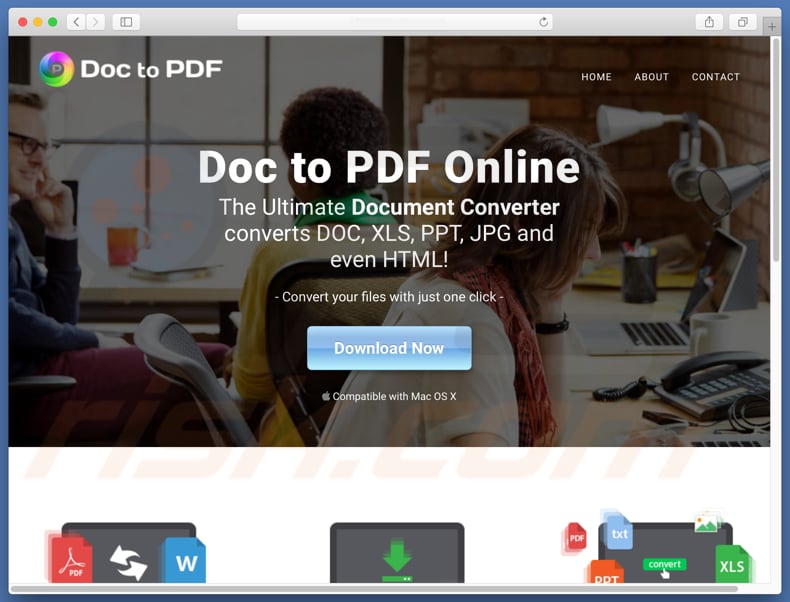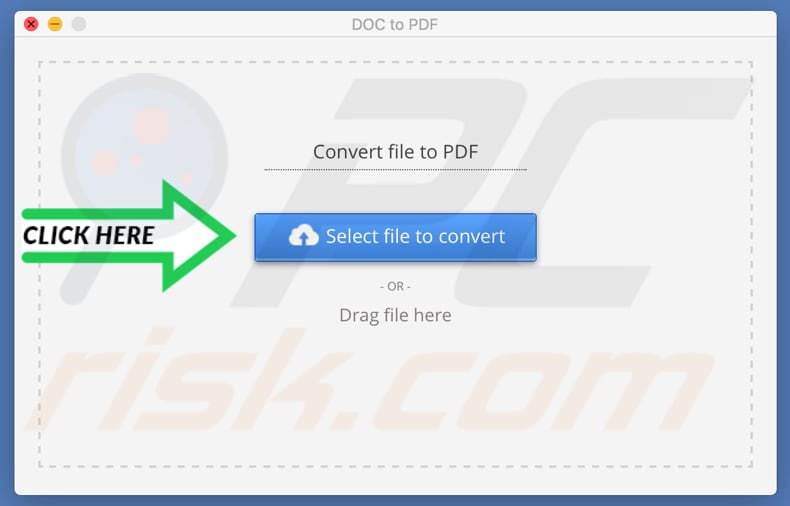Get free scan and check if your device is infected.
Remove it nowTo use full-featured product, you have to purchase a license for Combo Cleaner. Seven days free trial available. Combo Cleaner is owned and operated by RCS LT, the parent company of PCRisk.com.
What is DOC to PDF?
The DOC to PDF application is promoted as the ultimate document converter and capable of converting .doc, .xls, .ppt, .pdf, jpg, and various other files in one click.
Although this may seem to be a legitimate converter, it is also categorized as a potentially unwanted application (PUA), which people often install inadvertently - they are tricked into doing so. To achieve this, developers use a deceptive method called "bundling".

Once launched, DOC to PDF opens a simple window that allows users to convert files by dragging and dropping them into it.
This may seem like an easy-to-use application, however, as mentioned above, developers promote it using the "bundling" method and, therefore, they are usually designed to track/record information such as URLs of visited websites, geo-locations, IP addresses, search queries, and so on. Note that these apps can also record personal details.
Furthermore, developers of these unwanted apps share the information with third parties (possibly cyber criminals) who misuse it to generate revenue. Therefore, these applications might cause issues relating to privacy, browsing safety, or even identity theft.
PUAs often serve users with various advertisements (pop-ups, banners, coupons, surveys, and so on), many of which are intrusive.
They are displayed using tools that enable placement of third party graphical content on any site. If clicked, they might cause redirects to untrustworthy, deceptive (potentially malicious) websites and run scripts that download/install other unwanted applications. Since DOC to PDF is promoted using the "bundling" method, it is possible that this PUA also has this behavior.
| Name | Ads by DOC to PDF |
| Threat Type | Mac malware, Mac virus |
| Symptoms | Your Mac became slower than normal, you see unwanted pop-up ads, you get redirected to shady websites. |
| Distribution methods | Deceptive pop-up ads, free software installers (bundling), fake flash player installers, torrent file downloads. |
| Damage | Internet browsing tracking (potential privacy issues), displaying of unwanted ads, redirects to shady websites, loss of private information. |
| Malware Removal (Windows) |
To eliminate possible malware infections, scan your computer with legitimate antivirus software. Our security researchers recommend using Combo Cleaner. Download Combo CleanerTo use full-featured product, you have to purchase a license for Combo Cleaner. 7 days free trial available. Combo Cleaner is owned and operated by RCS LT, the parent company of PCRisk.com. |
Examples of other apps similar to DOC to PDF include Video Monkey, BeeAware, and ZipRar. Most apps of this type are promoted as 'useful and effective' - in this way, developers give the impression of legitimacy by offering features and tools that these apps supposedly provide.
In fact, PUAs are designed only to generate for the developers and provide none of the functionality promised.
How did DOC to PDF install on my computer?
DOC to PDF is available on a promotional website, however, apps of this type are often installed without users' knowledge. Developers of these apps use "bundling", a method used to trick people into downloading/installing potentially unwanted apps together with other software.
They hide information about the inclusion of these apps in "Custom", "Advanced" and other similar settings (or options) of the download/installation processes. Despite this, they are commonly installed when users inadvertently give them permission - by skipping installation/download steps and completing these procedures without checking all available settings.
How to avoid installation of potentially unwanted applications?
Download applications/software using trustworthy, reliable and official websites (or other channels). Do not use third party software downloaders/installers, tools such as torrents, eMule, and other similar sources. Check "Advanced", "Custom" and other settings of the download or installation procedures.
Deselect offers to install or download unwanted apps and only then finish the installation or download process. If you continually encounter ads that redirect you to dubious websites (gambling, pornography, adult dating, etc.), it is possible that adware or other unwanted apps are installed on your browser or MacOS.
Check the default browser for any unwanted extensions, plug-ins, and add-ons installed. Remove/uninstall all unwanted, unknown or suspicious applications immediately.
Also check the list of installed applications on the operating system. If your computer is already infected with DOC to PDF, we recommend running a scan with Combo Cleaner Antivirus for Windows to automatically eliminate this adware.
Screenshot of the DOC to PDF application:

Instant automatic malware removal:
Manual threat removal might be a lengthy and complicated process that requires advanced IT skills. Combo Cleaner is a professional automatic malware removal tool that is recommended to get rid of malware. Download it by clicking the button below:
DOWNLOAD Combo CleanerBy downloading any software listed on this website you agree to our Privacy Policy and Terms of Use. To use full-featured product, you have to purchase a license for Combo Cleaner. 7 days free trial available. Combo Cleaner is owned and operated by RCS LT, the parent company of PCRisk.com.
Quick menu:
- What is DOC to PDF?
- STEP 1. Remove DOC to PDF related files and folders from OSX.
- STEP 2. Remove DOC to PDF ads from Safari.
- STEP 3. Remove DOC to PDF adware from Google Chrome.
- STEP 4. Remove DOC to PDF ads from Mozilla Firefox.
Video showing how to remove DOC to PDF adware using Combo Cleaner:
DOC to PDF adware removal:
Remove DOC to PDF-related potentially unwanted applications from your "Applications" folder:

Click the Finder icon. In the Finder window, select "Applications". In the applications folder, look for "MPlayerX", "NicePlayer", or other suspicious applications and drag them to the Trash. After removing the potentially unwanted application(s) that cause online ads, scan your Mac for any remaining unwanted components.
DOWNLOAD remover for malware infections
Combo Cleaner checks if your computer is infected with malware. To use full-featured product, you have to purchase a license for Combo Cleaner. 7 days free trial available. Combo Cleaner is owned and operated by RCS LT, the parent company of PCRisk.com.
Remove adware-related files and folders

Click the Finder icon, from the menu bar. Choose Go, and click Go to Folder...
 Check for adware generated files in the /Library/LaunchAgents/ folder:
Check for adware generated files in the /Library/LaunchAgents/ folder:

In the Go to Folder... bar, type: /Library/LaunchAgents/

In the "LaunchAgents" folder, look for any recently-added suspicious files and move them to the Trash. Examples of files generated by adware - "installmac.AppRemoval.plist", "myppes.download.plist", "mykotlerino.ltvbit.plist", "kuklorest.update.plist", etc. Adware commonly installs several files with the exact same string.
 Check for adware generated files in the ~/Library/Application Support/ folder:
Check for adware generated files in the ~/Library/Application Support/ folder:

In the Go to Folder... bar, type: ~/Library/Application Support/

In the "Application Support" folder, look for any recently-added suspicious folders. For example, "MplayerX" or "NicePlayer", and move these folders to the Trash.
 Check for adware generated files in the ~/Library/LaunchAgents/ folder:
Check for adware generated files in the ~/Library/LaunchAgents/ folder:

In the Go to Folder... bar, type: ~/Library/LaunchAgents/

In the "LaunchAgents" folder, look for any recently-added suspicious files and move them to the Trash. Examples of files generated by adware - "installmac.AppRemoval.plist", "myppes.download.plist", "mykotlerino.ltvbit.plist", "kuklorest.update.plist", etc. Adware commonly installs several files with the exact same string.
 Check for adware generated files in the /Library/LaunchDaemons/ folder:
Check for adware generated files in the /Library/LaunchDaemons/ folder:

In the "Go to Folder..." bar, type: /Library/LaunchDaemons/

In the "LaunchDaemons" folder, look for recently-added suspicious files. For example "com.aoudad.net-preferences.plist", "com.myppes.net-preferences.plist", "com.kuklorest.net-preferences.plist", "com.avickUpd.plist", etc., and move them to the Trash.
 Scan your Mac with Combo Cleaner:
Scan your Mac with Combo Cleaner:
If you have followed all the steps correctly, your Mac should be clean of infections. To ensure your system is not infected, run a scan with Combo Cleaner Antivirus. Download it HERE. After downloading the file, double click combocleaner.dmg installer. In the opened window, drag and drop the Combo Cleaner icon on top of the Applications icon. Now open your launchpad and click on the Combo Cleaner icon. Wait until Combo Cleaner updates its virus definition database and click the "Start Combo Scan" button.

Combo Cleaner will scan your Mac for malware infections. If the antivirus scan displays "no threats found" - this means that you can continue with the removal guide; otherwise, it's recommended to remove any found infections before continuing.

After removing files and folders generated by the adware, continue to remove rogue extensions from your Internet browsers.
Remove malicious extensions from Internet browsers
 Remove malicious Safari extensions:
Remove malicious Safari extensions:

Open the Safari browser, from the menu bar, select "Safari" and click "Preferences...".

In the preferences window, select "Extensions" and look for any recently-installed suspicious extensions. When located, click the "Uninstall" button next to it/them. Note that you can safely uninstall all extensions from your Safari browser - none are crucial for regular browser operation.
- If you continue to have problems with browser redirects and unwanted advertisements - Reset Safari.
 Remove malicious extensions from Google Chrome:
Remove malicious extensions from Google Chrome:

Click the Chrome menu icon ![]() (at the top right corner of Google Chrome), select "More Tools" and click "Extensions". Locate all recently-installed suspicious extensions, select these entries and click "Remove".
(at the top right corner of Google Chrome), select "More Tools" and click "Extensions". Locate all recently-installed suspicious extensions, select these entries and click "Remove".

- If you continue to have problems with browser redirects and unwanted advertisements - Reset Google Chrome.
 Remove malicious extensions from Mozilla Firefox:
Remove malicious extensions from Mozilla Firefox:

Click the Firefox menu ![]() (at the top right corner of the main window) and select "Add-ons and themes". Click "Extensions", in the opened window locate all recently-installed suspicious extensions, click on the three dots and then click "Remove".
(at the top right corner of the main window) and select "Add-ons and themes". Click "Extensions", in the opened window locate all recently-installed suspicious extensions, click on the three dots and then click "Remove".

- If you continue to have problems with browser redirects and unwanted advertisements - Reset Mozilla Firefox.
Share:

Tomas Meskauskas
Expert security researcher, professional malware analyst
I am passionate about computer security and technology. I have an experience of over 10 years working in various companies related to computer technical issue solving and Internet security. I have been working as an author and editor for pcrisk.com since 2010. Follow me on Twitter and LinkedIn to stay informed about the latest online security threats.
PCrisk security portal is brought by a company RCS LT.
Joined forces of security researchers help educate computer users about the latest online security threats. More information about the company RCS LT.
Our malware removal guides are free. However, if you want to support us you can send us a donation.
DonatePCrisk security portal is brought by a company RCS LT.
Joined forces of security researchers help educate computer users about the latest online security threats. More information about the company RCS LT.
Our malware removal guides are free. However, if you want to support us you can send us a donation.
Donate
▼ Show Discussion